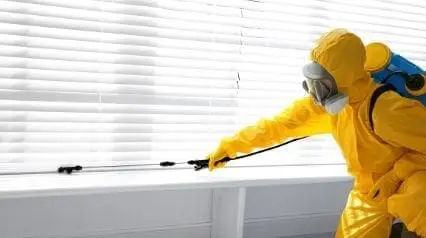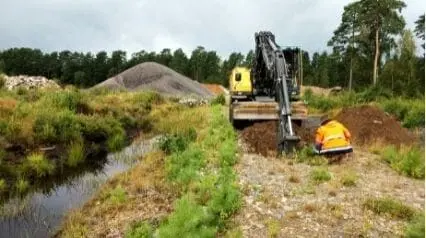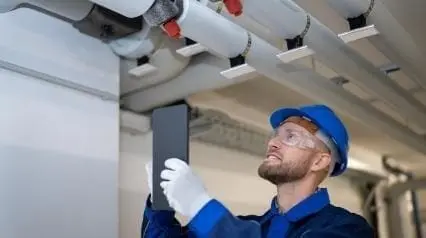What is Pest Inspection?
Pest inspection is when a trained professional searches a property for any sign of termites, bugs, critters, or other types of insects. It aims to detect symptoms of pest infestation early on, allowing for timely intervention and prevention measures to safeguard the property and its occupants.
Why Conduct Pest Inspections?
Pest inspection is an efficient way to prevent pests that can potentially cause health issues and structural property damage. Identifying the presence of pests and controlling the infestation can mitigate the risks of costly repairs and other health-related issues. Additionally, it can help:
- determine pest activity and identify the causes of the infestation;
- keep a safe and healthy working environment for employees and customers;
- minimize the potential of acquiring pest-borne diseases;
- keep out unwanted guests such as termites, ants, cockroaches, and others that can cause company reputational damage; and
- eliminate damage to physical assets caused by pests.
The 3 Most Common Types of Pests Found During Inspections
Unknowingly, pest infestations can happen in any area of a property, including the perimeter, basement, indoor areas, ceiling, etc. Pest inspections can help licensed pest control professionals identify pest problems and design control strategies. The most common types of pests identified during inspections are the following:
1. Termites
Termites abound in areas where there is wood, plaster, metal siding, and insulation, and where the climate is ideal for their nests. According to the National Pest Management Association (NPMA), termites caused over $5 billion in property damage annually in the United States alone. One of the most common ways to determine termite infestation is to check for swarming—which happens during the spring when winged termites emerge inside the property.
2. Bed Bugs
Hotel rooms, apartments, college dorms, residential bedrooms, and even office buildings, are susceptible to bed bug infestations. As NPMA reported, 1 in 5 Americans has had a bed bug infestation in their homes or knows someone who has encountered bed bugs in a hotel. To prevent the spread, perform bed bug inspections immediately and prepare bed bug reports to apply corrective actions as necessary.
3. Rodents
Rodents can cause serious property damage, including fire, by chewing wires and spilling flammable or hazardous chemicals. These problems can be avoided by maintaining a clean facility or warehouse and adhering to safe food storage guidelines.
Importance of Pest Inspection in Different Industries
Food Industry
Pests carry foodborne pathogens that can contaminate food and food contact surfaces which can lead to serious food poisoning. Being unable to control pest infestation can also damage a business’s reputation, and result in costly sanitation regulatory fines, lawsuits, or even fatalities.
Agriculture
Pest inspection plays a vital role in protecting the food supply and public health. The U.S. Environmental Protection Agency (EPA), U.S. Department of Health & Human Services, and the U.S. Department of Agriculture have prepared a list to identify pests of significant public health importance. Perform agriculture inspection to help identify and monitor the presence of harmful diseases, chemical residues, and pest infestations in produce to control it immediately.
Real Estate
Real estate properties are prone to pest infestations, including cockroaches, termites, and rodents, that could affect the overall structural integrity of the property. Pest control services can help ease the pain of property owners by exterminating these unwanted pests to avoid severe property damage.
Home inspections could help assess the physical condition of a property or building. It can identify any actual or potential structural issues and damage caused by pest infestations. Performing home inspections would help property owners foresee areas that need urgent repairs.
Hospitality
The presence of pests in the hospitality industry can be a big turnoff for customers. Maintaining hotel cleanliness is a big factor in minimizing the risk of future infestations. Utilizing hotel checklists can improve the quality of hotel amenities and services.
Improve your EHS Management
Cultivate a safe working environment and streamline compliance with our EHS solutions.
Explore nowHow to Conduct a Thorough Pest Inspection
Performing pest inspections entails checking numerous areas of a property (e.g., perimeter, basement, indoor areas, etc). It is important not to miss any spot to avoid re-inspection. Below are some best practices you can apply to help ensure property owners have good pest inspection reports:
Have the tools ready
To perform a pest inspection, you’ll need a few tools. Items such as flashlights, flushing agents or aerosols, magnifying glass, and a pen and paper to record your findings during the inspection.
Get down low
In doing inspections, especially indoors, it is helpful to get down low on your hands and knees with a flashlight to get a better look at the area for damages that could be a sign of pest activity.
Take photos as evidence
Photos are a great way to illustrate issues or problem areas in reports. Take or attach photos during the inspection and attach them to your reports. Inspectors will then take a look, examine, and come up with recommendations to help solve the issue depicted in the photo.
Use a digital checklist
A digital pest control checklist can serve as a guide when performing inspections. It helps you keep track of areas or items you need to check and gives you the efficiency of using your mobile or phone device in performing inspections for faster collation of data.
Create your own Pest Control Inspection checklist
Build from scratch or choose from our collection of free, ready-to-download, and customizable templates.
Browse Pest Control Inspection checklistsFAQs About Pest Inspections
Here are some important reminders to ensure the safety of employees when using pest control chemicals or other hazardous substances:
- Wear appropriate Personal Protective Equipment (PPE)
- Ensure proper training on chemical handling, storing, and disposing
- Use EPA-approved chemicals and do not mix them with other substances unless instructed
- Read chemical labels before usage
- Use the right chemicals for indoors and outdoors
- Keep a record of the collected data
There is a license to be a pest control operator, and these service operators need to comply with existing requirements, regulations, and standards. Businesses that need pest control services aren’t required to conduct pest control by law. Pest control requirements will differ by state and country. The BRC Global Standards for Food Safety, Storage, and Distribution require businesses to manage pests as a best practice for the food industry.
It’s recommended to get a pest inspection done before purchasing a property, during routine property maintenance, or if you suspect there may be a pest issue.
Pest inspections are typically conducted by licensed pest control professionals or pest inspectors trained to identify signs of pest infestations in buildings and properties. These professionals have the expertise to recognize various types of pests, such as termites, rodents, insects, and fungi, and assess the extent of any damage they may have caused.



